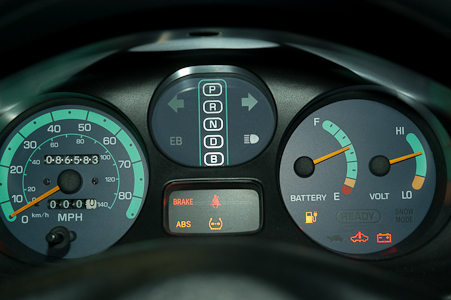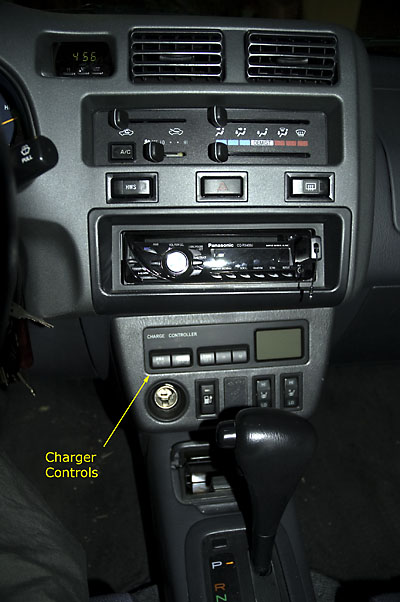
Inside, the RAV4 EV looks like an ordinary automatic transmission gasoline car
unless one looks rather closely.
The "ignition" system uses a normal key, which must be turned to
the "ignition" point before springing back to the operating position. For an
electric car, this seems to be an unnecessary emulation of a gasoline car
since the only thing that happens is that some lights flash.
In fact, at least once, it has confused a valet parking lot attendant who
thought the car wasn't starting up properly. After a long wait for our car,
we figured out what must have been happening and walked over to find the
attendant still trying to start the car.

The driver's instrument cluster consists of analog dials indicating charge state
in what appears to be linear 10% increments of battery capacity. The
RAV4 in practical use (for us) works out to a total range of around 100 miles,
so that each increment in the "fuel gage" conveniently corresponds to
about 10 miles of range. Dipping into last 20% of capacity lights up a
fuel warning icon - a gas pump with an electric plug. Who thought that
one up??? Going into the red (bottom 10%) puts the car into "reduced performance" mode which limits the acceleration allowed. A turtle icon lights up
if that happens — cute, perhaps, but I prefer having more real
feedback such as an indicator of the current being drawn from the
batteries to assist in driving conservatively for maximum range.
To the right of the "fuel gage" is a battery voltage indicator which in
most cases is useless. Not only are the units not marked, but there is
only one dividing mark (between the top green section and bottom yellow
section) indicating the "too low" threshold, whatever that is. In normal
use the needle is always up in the green section until you are near the
bottom of the battery capacity.
It does, however, turn out to be somewhat useful
at the point where the batteries are becoming worn out (somewhere around 80,000
miles for us). With old batteries, accelerating will cause the battery
voltage to drop. If the drop causes the needle to go into the yellow zone,
the car will go into reduced performance mode and thereafter limit the allowable
acceleration. The reduced performance mode will reset if the battery
voltage is allowed to recover to some point into the green. Thus, by
watching the voltage indicator while accelerating, we can avoid putting
the car into reduced performance operation.
Another indicator on the instrument cluster not found on gasoline cars is the
regen* indicator - "EB" for engine braking which indicates that
some light regen is applied when your foot comes off the accelerator. This
feels like the normal deceleration you get in a gasoline car when you take
your foot off the gas pedal. In the RAV4, this can be turned on and off
using a button on the "transmission" selector.

The transmission selector includes the standard ("P",
"R", "N", "D") positions, but also
allows you to go past "D" to "B", where heavy
regen deceleration (heavier than "EB" mode) is applied
when you remove your foot from the accelerator. However, this is
poorly implemented (seems like a software issue), causing a substantial
jerk when this is engaged and you remove your foot from the accelerator.
In practice, it is better to take your foot off the accelerator, and
then switch to "B" to reduce the jerk.
The center console instruments are also fairly standard, with the
exception of a set of controls to control charging and pre-conditioning
(heating or cooling) timers. In practice, these are not very useful
to us. We have set the charging timer to a fixed time at night
to take advantage of lower electricity rates after 9PM, but not
used any of the other features.
|
![]()
